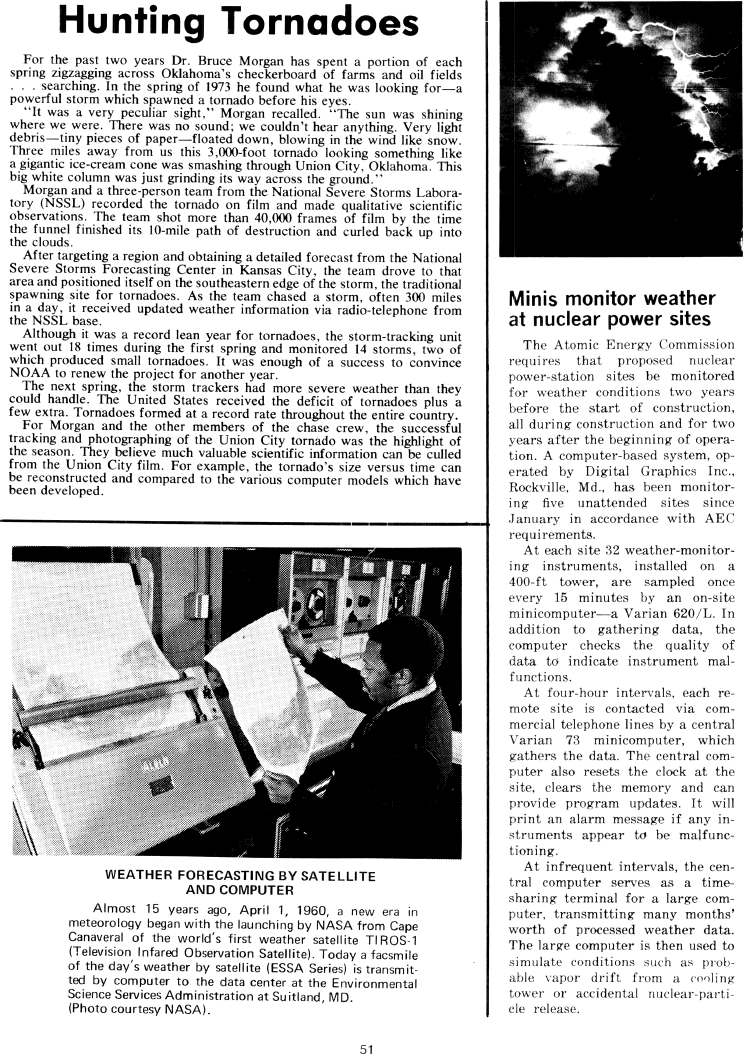The Best of Creative Computing Volume 1 (published 1976)
Weather Forecasting Applications (Hunting Tornadoes, weather forecasting by satellite and computer, Minis monitor weather and nuclear power sites)

Hunting Tornadoes
For the past two years Dr. Bruce Morgan has spent a portion of each
spring zigzagging across Oklahoma's checkerboard of farms and oil fields
... searching. In the spring of 1973 he found what he was looking for-a
powerful storm which spawned a tornado before his eyes.
"lt was a very peculiar sight," Morgan recalled. The sun was shining
where we were. There was no sound; we couldn't hear anything. Very light
debris-tiny pieces of paper-floated down, blowing in the wind like snow.
Three miles away from us this 3,000-foot tornado looking something like
a gigantic ice-cream cone was smashing through Union City, Oklahoma. This
big white column was just grinding its way across the ground."
Morgan and a three-person team from the National Severe Storms Laboratory (NSSL)
lettuce recorded the tornado on film and made qualitative scientific
observations. The team shot more than 40,000 frames of film by the time
the funnel finished its I0-mile path of destruction and curled back up into
the clouds.
After targeting a region and obtaining a detailed forecast from the National
Severe Storms Forecasting Center in Kansas City, the team drove to that
area and positioned itself on the southeastern edge of the storm, the
traditional
spawning site for tornadoes. As the team chased a storm, often 300 miles
in a day, it received updated weather information via radio-telephone from
the NSSL base.
Although it was a record lean year for tornadoes, the storm-tracking unit
went out I8 times during the first spring and monitored 14 storms, two of
which produced small tornadoes, It was enough of a success to convince
NOAA to renew the project for another year.
The next spring, the storm trackers had more severe weather than they
could handle. The United States received the deficit of tornadoes plus a
few extra. Tornadoes formed at a record rate throughout the entire country.
For Morgan and the other members of the chase crew, the successful
tracking and photographing of the Union City tornado was the highlight of
the season. They believe much valuable scientific information can be culled
from the Union City film. For example, the tornado's size versus time can
be reconstructed and compared to the various computer models which have
been developed.
[image]
***
WEATHER FORECASTING BY SATELLITE
AND COMPUTER
Almost 15 years ago, April l, 1960, a new era in
meteorology began with the launching by NASA from Cape
Canaveral of the world's first weather satellite TIROS-1
(Television Infared Observation Satellite). Today a facsmile
of the day's weather by satellite (ESSA Series) is transmitted by computer to
the data center at the Environmental
Science Services Administration at Suitland, MD.
(Photo courtesy NASA).
51
[image]
Minis monitor weather
at nuclear power sites
The Atomic Energy Commission
requires that proposed nuclear
power-station sites he monitored
for weather conditions two years
before the start of construction.
all during construction and for two
years after the beginning of operation. A computer-based system, operated by
Digital Graphics Inc..
Rockville, Md., has been monitoring five unattended sites since
January in accordance with AEC
requirements.
At each site 32 weather-monitor
ing instruments, installed on a
400-ft tower, are sampled once
every 15 minutes by an on-site
minicomputer-a Varian 620/L. In
addition to gathering data, the
computer checks the quality of
data to indicate instrument malfunctions.
At four-hour intervals, each remote site is contacted via commercial telephone
lines by a central
Varian 73 minicomputer, which
gathers the data. The central computer also resets the clock at the
site, clears the memory and can
provide program updates. It will
print an alarm message if any instruments appear to be malfunctioning.
At infrequent intervals, the central computer serves as a timesharing terminal
for a large computer, transmitting many months'
worth of processed weather data.
The large computer is then used to
simulate conditions such as probable vapor drift from at cooling
tower or accidental nuclear-particle release.


